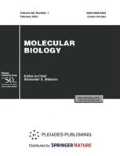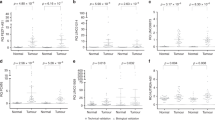Abstract
Recently, a wealth of data have been accumulating on the role of long non-coding RNAs (lncRNAs) in the fine-tuning of mRNA expression. Four new lncRNAs, namely, TMEM92-AS1, FAM222A-AS, TXLNB, and lnc-CCL28, were identified as differentially expressed in ovarian tumors using deep machine learning. The levels of lnc-CCL28 transcripts in both tumors and normal tissue samples were sufficient for further analysis by RT-PCR. In addition, the promising ovarian cancer biomarkers, lncRNAs LINC00152, NEAT1 and SNHG17 were added to RT-PCR analysis. For the first time, an increase in the level of lnc-CCL28 and SNHG17 lncRNAs was found in ovarian tumors, and the overexpression of LINC00152 and NEAT1 was confirmed. It seems that lnc-CCL28 is involved in carcinogenesis and, in particular, in ovarian cancer progression. Overexpression of LINC00152 and lnc-CCL28 was significantly associated with the later stages and metastasis.


Similar content being viewed by others

REFERENCES
Kung J.T.Y., Colognori D., Lee J.T. 2013. Long noncoding RNAs: Past, present, and future. Genetics. 193 (3), 651–669.
Brannan C.I., Dees E.C., Ingram R.S., Tilghman S.M. 1990. The product of the H19 gene may function as an RNA. Mol. Cell. Biol. 10 (1), 28–36.
Wunderlich Z., Mirny L.A. 2009. Different gene regulation strategies revealed by analysis of binding motifs. Trends Genet. 25 (10), 434–440.
Yao R.-W., Wang Y., Chen L.-L. 2019. Cellular functions of long noncoding RNAs. Nat. Cell Biol. 21 (5), 542–551.
Fang Y., Fullwood M.J. 2016. Roles, functions, and mechanisms of long non-coding RNAs in cancer. Genomics Proteomics Bioinformatics. 14 (1), 42–54.
Mercer T.R., Dinger M.E., Mattick J.S. 2009. Long non-coding RNAs: Insights into functions. Nat. Rev. Genet. 10 (3), 155–159.
López-Urrutia E., Bustamante Montes L.P., Ladrón de Guevara Cervantes D., Pérez-Plasencia C., Campos-Parra A.D. 2019. Crosstalk between long non-coding RNAs, micro-RNAs and mRNAs: Deciphering molecular mechanisms of master regulators in cancer. Front. Oncol. 9, 669.
Loginov V.I., Pronina I.V., Burdennyy A.M., Filippova E.A., Kazubskaya T.P., Kushlinsky D.N., Utkin D.O., Khodyrev D.S., Kushlinskii N.E., Dmitriev A.A., Braga E.A. 2018. Novel miRNA genes deregulated by aberrant methylation in ovarian carcinoma are involved in metastasis. Gene. 662, 28–36.
Filippova E.A., Loginov V.I., Burdennyi A.M.,Braga E.A., Pronina I.V., Kazubskaya T.P., Kushlinskii D.N., Utkin D.O., Fridman M.V., Khodyrev D.S., Kushlinskii N.E. 2019. hypermethylated genes of microrna in ovarian carcinoma: Metastasis prediction marker systems. Bull. Exp. Biol. Med. 167 (1), 79–83.
Zhou J., Zhi X., Wang L., Wang W., Li Z., Tang J., Wang J., Zhang Q., Xu Z. 2016. Erratum to: Linc00152 promotes proliferation in gastric cancer through the EGFR-dependent pathway. J. Exp. Clin. Cancer Res. 35, 30.
Seo D., Kim D., Kim W. 2019. Long non-coding RNA linc00152 acting as a promising oncogene in cancer progression. Genomics Inform. 17 (4), e36.
Cai Q., Wang Z.-Q., Wang S.-H., Li C., Zhu Z.-G., Quan Z.-W., Zhang W.-J. 2016. Upregulation of long non-coding RNA LINC00152 by SP1 contributes to gallbladder cancer cell growth and tumor metastasis via PI3K/AKT pathway. Am. J. Transl. Res. 8 (10), 4068–4081.
Shigemasa K., Katoh O., Shiroyama Y., Mihara S., Mukai K., Nagai N., Ohama K. 2002. Increased MCL-1 expression is associated with poor prognosis in ovarian carcinomas. Jpn. J. Cancer Res. Gann. 93 (5), 542–550.
Chakravarty D., Sboner A., Nair S.S., Giannopoulou E., Li R., Hennig S., Mosquera J.M., Pauwels J., Park K., Kossai M., MacDonald T.Y., Fontugne J., Erho N., Vergara I.A., Ghadessi M., Davicioni E., et al. 2014. The oestrogen receptor alpha-regulated lncRNA NEAT1 is a critical modulator of prostate cancer. Nat. Commun. 5, 5383.
Lebedeva S., Jens M., Theil K., Schwanhäusser B., Selbach M., Landthaler M., Rajewsky N. 2011. Transcriptome-wide analysis of regulatory interactions of the RNA-binding protein HuR. Mol. Cell. 43 (3), 340–352.
Mitsunari K., Miyata Y., Asai A., Matsuo T., Shida Y., Hakariya T., Sakai H. 2016. Human antigen R is positively associated with malignant aggressiveness via upregulation of cell proliferation, migration, and vascular endothelial growth factors and cyclooxygenase-2 in prostate cancer. Transl. Res. 175, 116–128.
Du Y., Wei N., Hong J., Pan W. 2020. Long non-coding RNASNHG17 promotes the progression of breast cancer by sponging miR-124-3p. Cancer Cell Int. 20, 40.
Smyth G.K. 2005. limma: Linear Models for Microarray Data. In: Bioinformatics and Computational Biology Solutions Using R and Bioconductor. Statistics for Biology and Health. Eds. Gentleman R., Carey V.J., Huber W., Irizarry R.A., Dudoit S. New York: Springer, pp. 397–420. https://doi.org/10.1007/0-387-29362-0_23
Pearson K.F.R.S. 1901. LIII. On lines and planes of closest fit to systems of points in space. Lond. Edinb. Dublin Philos. Mag. J. Sci. 2 (11), 559–572. https://doi.org/10.1080/14786440109462720
Hinton G.E., Roweis S. 2002. Stochastic neighbor embedding. Adv. Neural Inf. Process. Syst. 15, 857–864.
Chen T., Guestrin C. 2016. XGBoost: A scalable tree boosting system. In: Proceedings of the 22nd ACM SIGKDD International Conference on Knowledge Discovery and Data Mining, pp. 785–794. https://doi.org/10.1145/2939672.2939785
UICC. 1987. TNM Classification of Malignant Tumours, 4th ed. Eds. Hermanek P., Sobin L.H. Berlin: Springer-Verlag.
WHO. 2014. WHO Classification of Tumours of Female Reproductive Organs, 4th ed. Eds. Kurman R., Carcangiu M.L., Herrington C.S., Young R.H. Lyon: IARC Press, vol. 6.
Pronina I.V., Loginov V.I., Khodyrev D.S., Kazubskaya T.P., Braga E.A. 2012. RASSF1A expression level in primary epithelial tumors of various locations. Mol. Biol. 46, 236–243. https://doi.org/10.1134/S0026893312010189
Chai Y., Liu J., Zhang Z., Liu L. 2016. HuR-regulated lncRNA NEAT1 stability in tumorigenesis and progression of ovarian cancer. Cancer Med. 5 (7), 1588–1598.
Gong J., Zhang J.-P., Li B., Zeng C., You K., Chen M.-X., Yuan Y., Zhuang S.-M. 2013. MicroRNA-125b promotes apoptosis by regulating the expression of Mcl-1, Bcl-w and IL-6R. Oncogene. 32 (25), 3071–3079.
Chen D., Si W., Shen J., Du C., Lou W., Bao C., Zheng H., Pan J., Zhong G., Xu L., Fu P., Fan W. 2018. miR-27b-3p inhibits proliferation and potentially reverses multi-chemoresistance by targeting CBLB/GRB2 in breast cancer cells. Cell Death Dis. 9 (2), 188. https://doi.org/10.1038/s41419-017-0211-4
Funding
This work was supported by the Russian Science Foundation (grant no. 20-15-00368).
Author information
Authors and Affiliations
Contributions
O.I.B. and I.V.P. made equal contributions.
Corresponding author
Ethics declarations
Conflict of interests. The authors declare that they have no conflicts of interest.
Statement of compliance with standards of research involving humans as subjects. All procedures performed in this work are in accordance with the ethical standards of the institutional committee on research ethics and the 1964 Declaration of Helsinki and its subsequent amendments or comparable standards of ethics. Written informed consent was obtained from all patients.
Rights and permissions
About this article
Cite this article
Brovkina, O.I., Pronina, I.V., Uroshlev, L.A. et al. Identification of Novel Differentially Expressing Long Non-Coding RNAs with Oncogenic Potential. Mol Biol 55, 548–554 (2021). https://doi.org/10.1134/S0026893321020175
Received:
Revised:
Accepted:
Published:
Issue Date:
DOI: https://doi.org/10.1134/S0026893321020175



